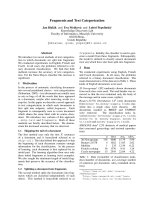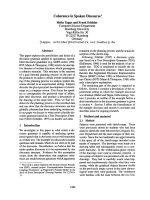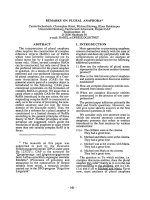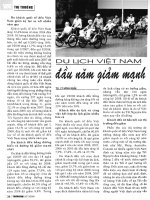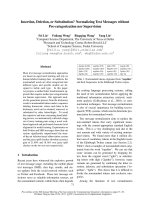báo cáo khoa học: "Patient, prisoner or person?" pptx
Bạn đang xem bản rút gọn của tài liệu. Xem và tải ngay bản đầy đủ của tài liệu tại đây (167.48 KB, 2 trang )
BioMed Central
Page 1 of 2
(page number not for citation purposes)
Harm Reduction Journal
Open Access
Commentary
Patient, prisoner or person?
Dan Small*
1,2
Address:
1
Director PHS Community Services Society, 20 West Hastings Street, Vancouver, BC, V6B 1G6, Canada and
2
Research Associate,
Department of Anthropology and Sociology, University of British Columbia, Vancouver, BC, V6T 1Z1, Canada
Email: Dan Small* -
* Corresponding author
Abstract
Case studies provide rich descriptions of significant vignettes that highlight atypical systemic or
clinical problems and identify potentially important research questions. The case study presented
by Venters, Razvi, Tobia and Drucker (2006) describes an unfortunate set of events pertaining to
an individual's experience as they were failed by s several systems all at once and neglected for
having had experience with an addiction. This commentary provides some remarks on the case
study with respect to differing institutional narratives as they pertain to lived experience in the
context of everyday life. It is suggested that, in the special case of addiction, the mistreatment of
the subject of the case study, Mr. Ortiz, is not an exception to the norm, but the norm itself for
people living with addictions and their families.
The case study presented by the Venters, Razvi, Tobia and
Drucker [1] in this volume portrays, all at once, a legal
failing, a medical misadventure and personal tragedy. To
the various systems, Mr. Ortiz is part patient, part prisoner
and part person. The criminal justice plot line begins with
a prisoner on the road to rehabilitation. Mr. Ortiz's lack of
access to adequate healthcare (i.e. testing and treatment
for HCV) indicates how his personhood was diminished
within this setting. A public health narrative would have,
presumably, offered a different beginning, middle and
end point where the central character would have been
seen as a site for illness, disease and treatment. Rich
descriptions of individual experience like this one help us
to identify gaps in service and to define relevant research
questions. But they do something more; they identify our
professional shortcomings and the way that systems, of
which we are all a part, often fail the people with the most
needs.
Differing institutional narratives, like the ones described
in the present case study, can lead to dramatically differ-
ent outcomes for patients and persons. For example, in a
comparison between two hospitals, it was discovered that
in one hospital, physicians limited at least one type of life
prolonging equipment for 1 in 4 (25%) patients dis-
charged from the ICU whereas doctors in another hospital
imposed these limitations in only 1 in 7 (14%) patients
[2]. Interviews revealed that there were not any significant
differences in the medical or ethical orientations of the
physicians in the two hospitals. In fact, the key decisions
about end of life care were imposed on the physicians by
the administrators in the respective hospitals based on
their differing analyses of the risk of lawsuits following the
removal of patients from respirators.
Notwithstanding, these systems are still, at their very
heart, comprised of human beings, professionals, with the
capacity to reflect upon institutional arrangements and to
put their client's narrative, rather than the institutional
Published: 07 August 2006
Harm Reduction Journal 2006, 3:23 doi:10.1186/1477-7517-3-23
Received: 17 July 2006
Accepted: 07 August 2006
This article is available from: />© 2006 Small; licensee BioMed Central Ltd.
This is an Open Access article distributed under the terms of the Creative Commons Attribution License ( />),
which permits unrestricted use, distribution, and reproduction in any medium, provided the original work is properly cited.
Publish with Bio Med Central and every
scientist can read your work free of charge
"BioMed Central will be the most significant development for
disseminating the results of biomedical research in our lifetime."
Sir Paul Nurse, Cancer Research UK
Your research papers will be:
available free of charge to the entire biomedical community
peer reviewed and published immediately upon acceptance
cited in PubMed and archived on PubMed Central
yours — you keep the copyright
Submit your manuscript here:
/>BioMedcentral
Harm Reduction Journal 2006, 3:23 />Page 2 of 2
(page number not for citation purposes)
narrative, at the centre of care. The only way to bring the
differing narratives of various systems (e.g health, crimi-
nal justice, legal, personal) together so that they share a
common plot line is by encouraging professional and
institutional reflexivity (self awareness within systems).
This self-awareness begins by encouraging professional
understanding about the way institutions typically fit peo-
ple to systems rather than systems to people. By promot-
ing understanding of institutional narratives, we can work
towards systemic accountability and, ultimately, a more
person-centred design.
Why person-centred? For the reason that the experience of
illness, like HCV, doesn't really occur in the criminal jus-
tice system, courtroom or clinics.
It occurs in a deeply more personal landscape; the life-
world. It is Mr. Ortiz who will ultimately have to negotiate
the impact of these fateful moments on his personhood.
By adopting a reflective approach, where we put the expe-
rience of those most affected by systems in the centre of
our narrative, we can move beyond the sad story at the
heart of this case to ensure that this is not a normal expe-
rience, but an exception.
References
1. Venters HD, Razvi AM, Tobia MS, Drucker E: The Case of Scott
Ortiz: A clash between criminal justice and public health.
Harm Reduction Journal 2006.
2. Zussman R: Intensive Care: Medical Ethics and the Medical
Profession. Chicago , The University of Chicago; 1992.

